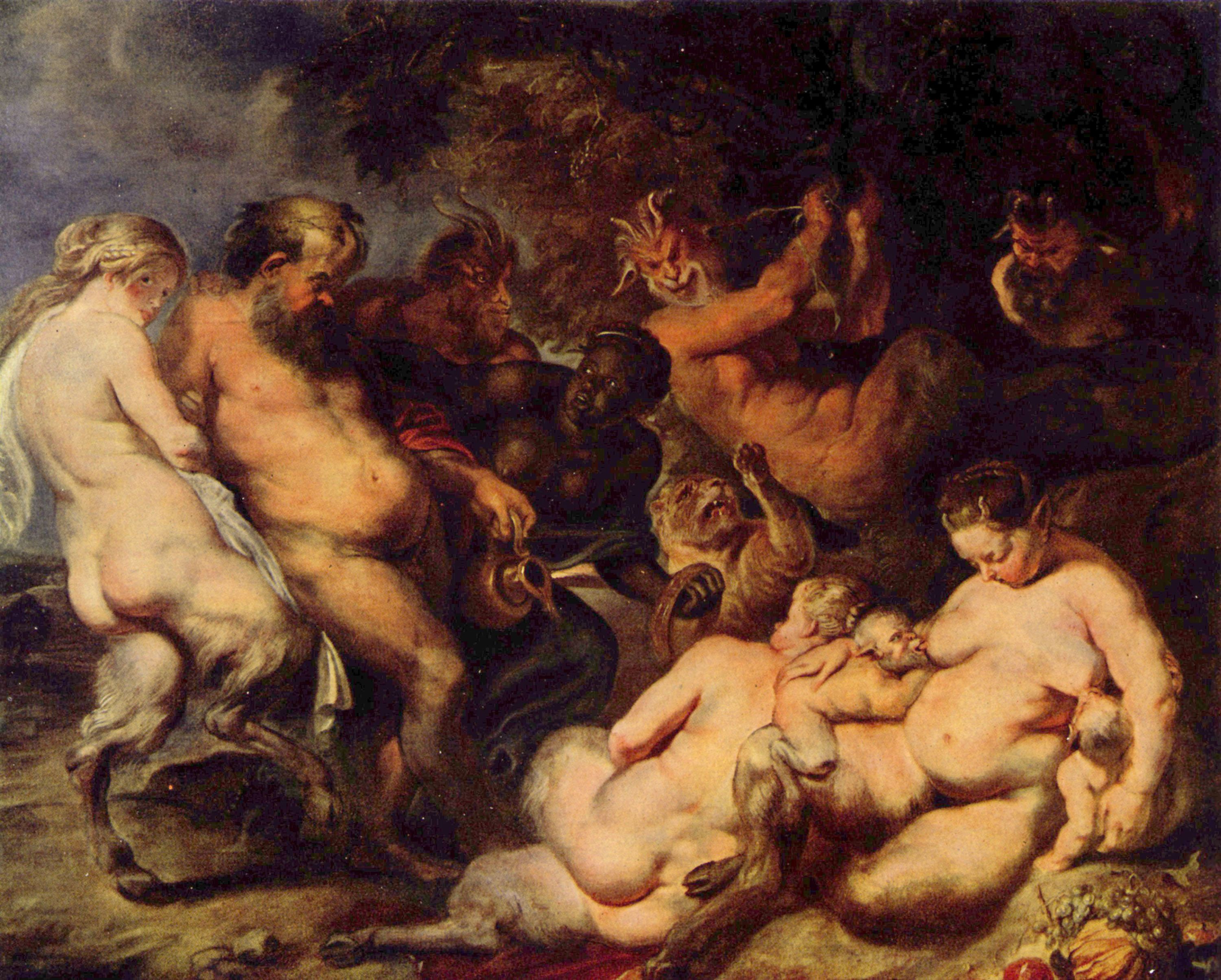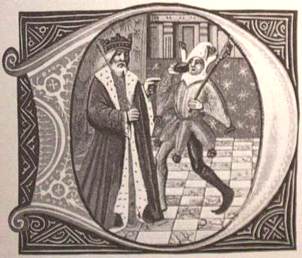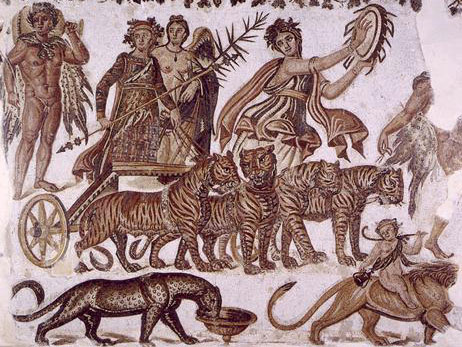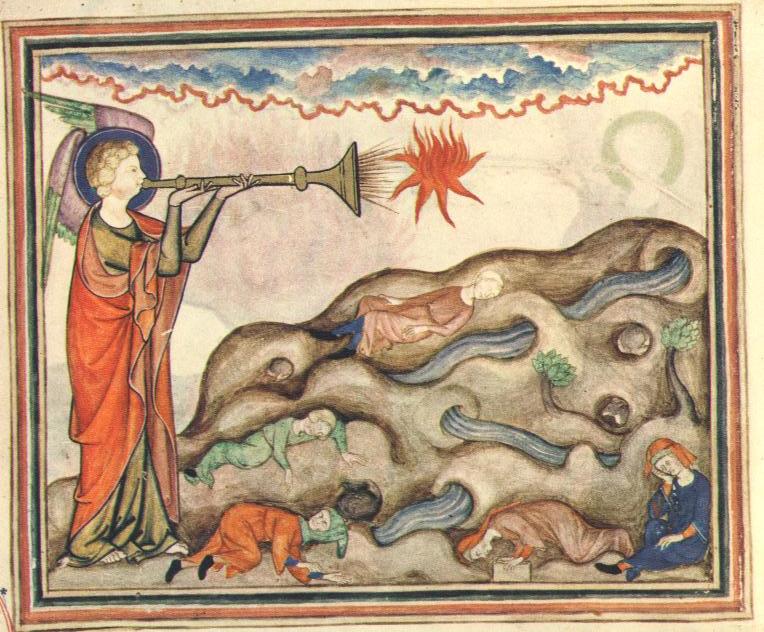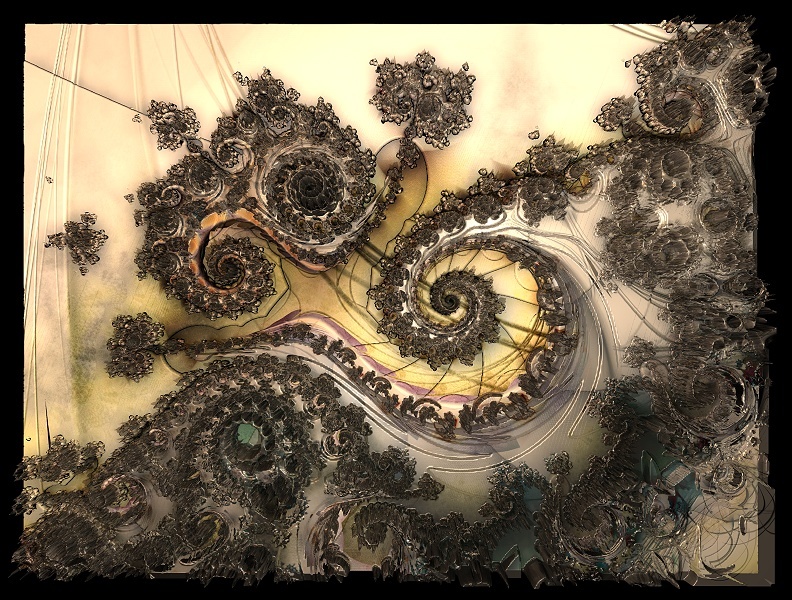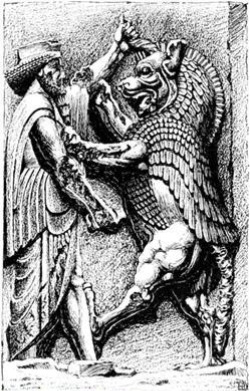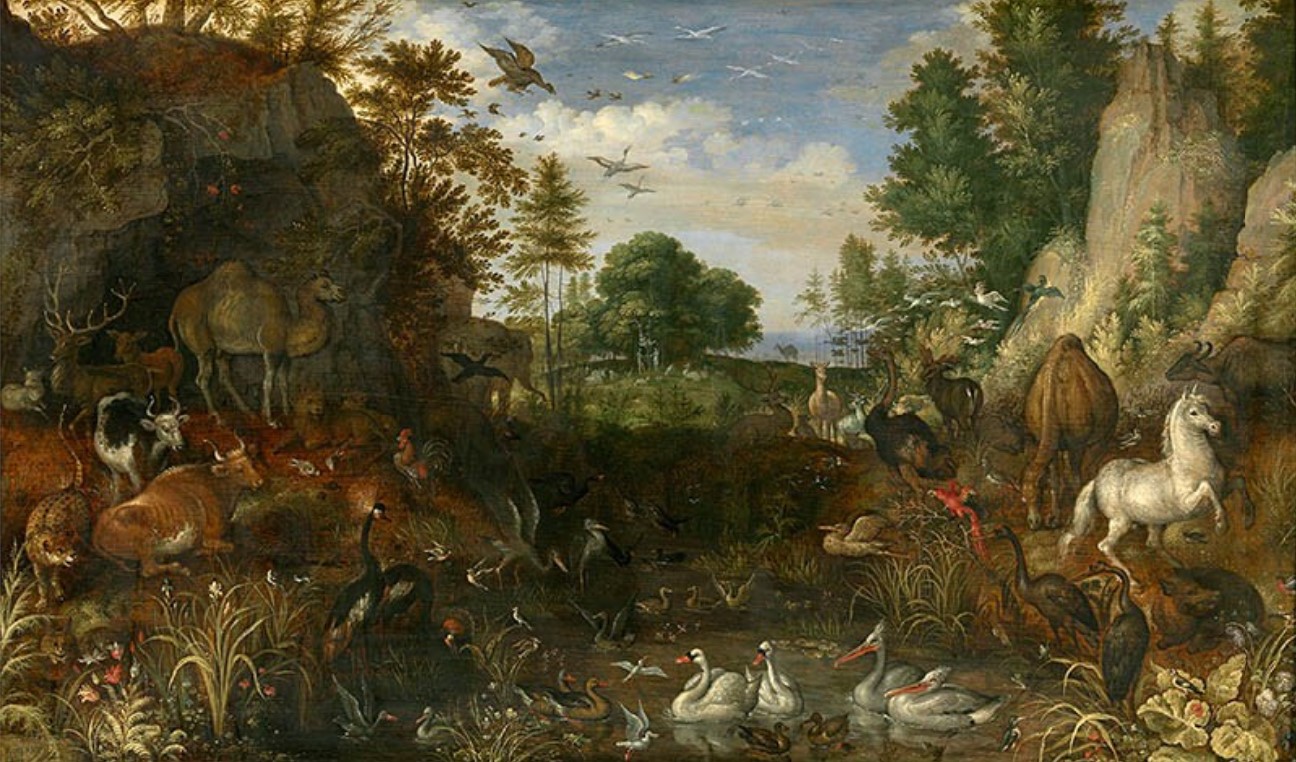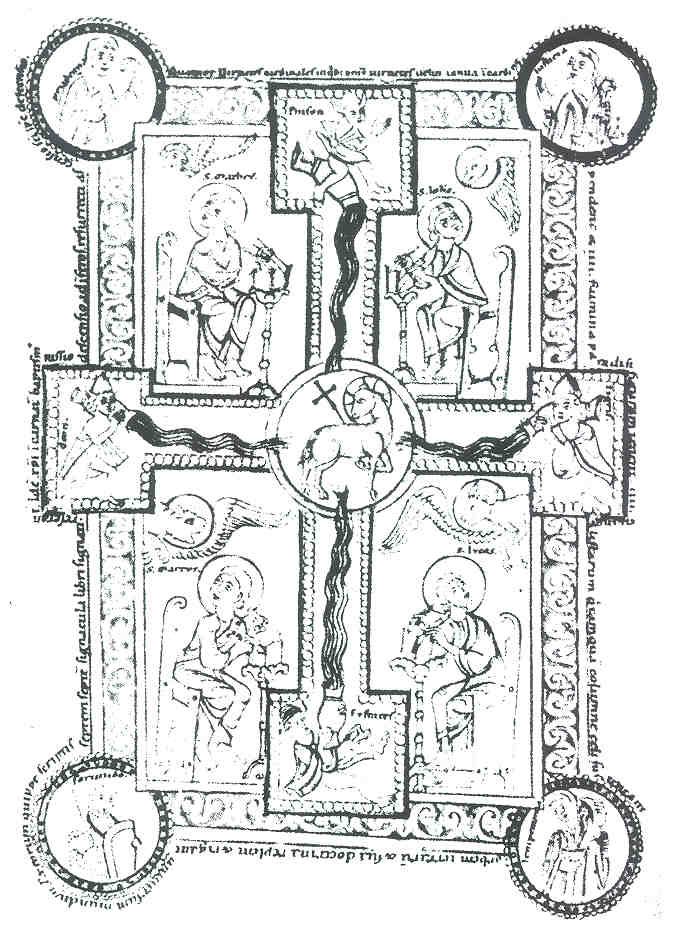Yet may we not see still the brontoichthyan form outlined aslumbered, even in our own nighttime by the sedge of the troutling stream that Bronto loved and Brunto has a lean on.
Sprites of Syntax
In the visions of Terence McKenna and Philip K. Dick, the encountered intelligence is called by both "the Logos" and it is described as being "living information." McKenna, perhaps more than Dick, speculates extensively on the actual structure of this living information.
McKenna is well-known for his outlandish yet lyrical descriptions of the "machine elves" -- imaginal entities that spring up from the woodwork during the flash of a DMT trip. In one of his talks, "In the Valley of Novelty," he explains the relation of these entities to language:
On DMT, these entities – these machine-like, diminutive, shape-shifting, faceted machine elf type creatures that come bounding out of the state – they come bounding out of my stereo speakers, if I have my eyes open – they are like, you know, they are elfin embodiments of syntactical intent. Somehow syntax, which is normally the invisible architecture behind language, has moved into the foreground. And you can see it! I mean, it’s doing callisthenics and acrobatics in front of you! It’s crawling all over you! And what’s happened is that your categories have been scrambled, or something; and this thing which is normally supposed to be invisible and in the background and an abstraction has come forward and is doing handsprings right in front of you.

The "invisible architecture behind language" takes on elfin forms right before our eyes. This is deeply mind-blowing. Not only is information or language alive in an abstract sense, but it is also embodied in a way that is virtually biological. And not only does it present itself in organic form, but it desires to play, to communicate. The way that these visible, syntactical sprites attempt to do this is also unique. They create almost impossible "linguistic objects" for us to behold with all of our senses.
And the thing makes linguistic objects; it sheds syntactical objectification. So that it comes towards you – they come toward you – they divide, they merge, they’re bounding, they’re screaming, they’re squeaking – and they hold out objects, which they sing into existence, or which they pull out of some other place. And these things are, you know, like jewels and lights, but also like consommé and old farts and yesterday and high speed; in other words, they are made of juxtapositions of qualities that are impossible in three-dimensional space.
These impossible juxtapositions of linguistic "stuff" should sound very familiar to anyone who has been following this blog. McKenna is describing, and the machine elves are creating, vast dancing panoplies of visual and other sensory puns. And this is exactly how they are depicted by McKenna in the talk.

What they’re like is – and in fact, this is probably what they are – what they’re like is, they’re like three- and four- and five-dimensional puns. And you know how the pleasure of a pun lies in the fact that it is... it’s not that the meaning flickers from A to B; it’s that it’s simultaneously A and B, and when the pun is really funny it’s an A,B,C,D pun; and it’s simultaneously all these things... well, that quality, which in our experience can only occur to an acoustical output or a glyph which stands for an acoustical output – in other words, a printed pun – in the DMT world, objects can do this. Objects can simultaneously manifest more than one nature at once. And, something like a pun, the result is always funny. It’s amusing! You cannot help but be delighted by this thing doing this thing.
Multi-dimensional, multi-sensory, multi-contextual, ever-moving puns created by embodied aspects of language itself! This space, wherever DMT and similar substances take us -- within our own personal subconscious, within the collective unconscious, or to different realms entirely, is a space where language creates language. As McKenna taught, by entering this shamanic space and successfully being able to bring something back from it -- to remember it -- is to enrich and expand our world by stretching the bounds of what we think is imaginatively possible.

The pun in particular breaks down the imposed but arbitrary borders of the world by causing us to think and experience two or more entirely different, and even contradictory, thoughts at once. Like synchronicity, the pun is the means by which Zebra is dismantling the illusion of Empire brick by brick and wall by wall.
The Barrel of a Pun
Of course, when the word "pun" is mentioned here Finnegans Wake is immediately recalled. It is the masterpiece of the pun. It has been "constructed" in such a way that the puns of every sentence, nearly every word, resonate with each other in a different fashion each time the book is "read." Clusters of puns pun with other clusters of puns.
The creation of new meaning becomes exponential. The page is a two-dimensional medium, but the combinations of meaning and nonsense is so complex that things jump out of the book. This is the forested abode of the machine elves -- a "forest of symbols" in the words of Baudelaire.
The Wake is, paraphrasing Umberto Eco, an organic machine designed to create infinite salience. It also reveals, even more subversively, that all books do this, all language contains this. FW is DMT pressed into page-sized blotter and absorbed through reading. It is an ongoing, cataclysmic alien assault on our fallen reality.
One question always haunts "readers" of the Wake. If it is a dream, whose dream is it? It seems very unlikely that it presents the subconscious ruminations, the Freudian "day residues," of Humphrey Earwicker, Dublin pub- and innkeeper. One creative theory suggests that the Wake is the combined dream of Molly and Leopold Bloom sleeping head to foot, yin-yang style, in the early hours of June 17th, 1904.

In a letter, though, Joyce is unusually clear about who is dreaming. He writes that Finnegans Wake "signifies at once the wake and the awakening of Finn." HCE is only a reincarnation, a "metempyschosis," of Finn MacCool.
Stuttering Hand
Finn MacCool, or Fionn mac Cumhaill, was a mythical warrior of ancient Ireland and the son of a great leader. As a boy he left his home and came to be the servant of the shaman-poet, Finn Eces. This strange yet powerful man was on a quest to catch the Salmon of Wisdom, a fish whose flesh would grant all of the world's knowledge to the first person who ingested it.
The salmon had itself eaten nine hazelnuts that had fallen into the primordial Well of Wisdom, the ultimate source of Ireland's major rivers. After seven years, Finn Eces finally caught the fish and, desiring to eat it and attain omniscience, asked his young apprentice, Finn MacCool, to cook it for his dinner. The story goes, though, that young Finn, while touching the fish to test if it was cooked, burned himself on the scalding fish fat and bit his thumb in pain. The fat touched his tooth and all of the knowledge of the world flowed into the mind of Finn MacCool.
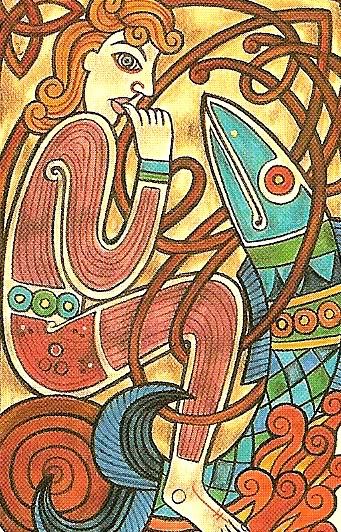
Finnegans Wake, then, is the dream of one who knows, or once knew, everything. However, as the illuminating essay, "Celtic Cauldrons at the Wake," explains the Wake is the story of the Fall of Finn and the forgetting of this knowledge. It cites an old passage which describes how Finn performed a rite of divination to access all that he had learned:
Then a basin of bright gold was brought to Finn, and he washed his white hands and his ruddy bright face. He put his thumb under his tooth of knowledge, and the truth was revealed to him then, and falsehood was concealed from him.
By washing in a sacred cauldron and placing his thumb to his tooth he could recall everything ever known. In the Wake, however, it is suggested that Finn somehow lost this power, that the cauldron became dry, and that this act of forgetting is equated with the Fall:
Finn, with his occasionally "Stuttering Hand” (4.18), attempts to perform this very rite in the opening episode of the Wake: one yesterday, he sternly stuck his head in a tub (4.21-22), to "watsch the future of his fates” (wash the features of his face; watch the future of his fates [4.22]). But HCE/Finn finds that all the water in his ritualistic basin has “eviparated” (4.24). Unable to either wash the features of his face (as a prelude to divination) or watch the future of his fates (through cauldron divination), HCE begins to lose the bright knowledge--a dire portent and the prelude to his fall, and appropriately perceived through one of the visionary vessels of the ancient Celts.
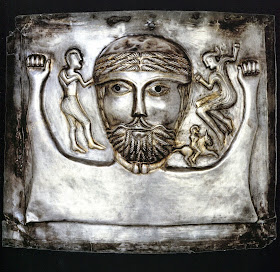
All of the symbols being tracked on this blog -- the cauldron, the fish, the tooth, the feminine waters of the sacred river -- are present in the story. This tale of the young Finn is equivalent to the Welsh story of the poet Taliesin, mentioned before in this blog. Identical symbols are involved in the anamnesis experience of Philip K. Dick in February of 1974.
Dick is suffering from an impacted wisdom tooth when he meets a young woman at his door wearing a fish symbol necklace. The woman herself -- the dark-haired girl -- appears frequently in Dick's writing and is the embodiment of the divine Sophia. She is equivalent to the river goddess Annah of Irish myth. The symbol of the cauldron, grail or cup in Dick's writing is the subject of a previous post.
The most remarkable thing, though, is that these events show two different episodes in the same story. Finn is forgetting or falling asleep, and Dick is in the process of remembering or waking up.
There is a fish at the start of the story and a fish at the end. Two fishes.
The Two Sons of God
These two fishes are the subject of a major study by Carl Jung entitled Aion. In this text, Jung makes the case that the original early Christian ichthys symbol -- the one which blasted PKD to his core when it appeared on his doorstep -- is related to the two fishes comprising the astrological sign of Pisces.

The over two thousand years of the Age of Pisces has almost entirely coincided with the age of Christianity. Jung is quick to emphasize, though, that "there is no evidence in the old literature that the Christian fish symbolism was derived from the zodiac," and that the connection he makes is purely a "synchronistic concomitant."
As a synchronicity, though, it is extremely profound. One problem in attempting to correspond these two symbols is that the first has one fish and the second has two. In Jung's view, though, the Pisces symbol is merely more complete. He explains "that in the astrological interpretation Christ is in fact only one of the fishes, the role of the other fish being allotted to the Antichrist." The ichthys refers just to Christ, ruling over the first thousand years of the Age, while the Antichrist is the second inverted fish of the zodiacal sign.
Astrologically interpreted, the designation of Christ as one of the fishes identifies him with the first fish, the vertical one. Christ is followed by the Antichrist, at the end of time. The beginning of the enantiodromia would fall, logically, midway between the two fishes. We have seen that this is so. The time of the Renaissance begins in the immediate vicinity of the second fish, and with it comes that spirit which culminates in the modern age.

Jung characterizes this spirit with the process of "dechristianization" in the West coinciding with "the Luciferian development of science and technology." He notes how the immense and almost unimaginable destruction of World War Two was often compared with the terrible vision of the end of the world and the coming of the Antichrist as presented in the New Testament. Without a doubt this same Luciferian and destructive spirit still dominates the present.
For Jung, just as every individual has a shadow side so there is a "dark half of the human totality, which ought not to be judged too optimistically." This dark side is precisely represented by the Antichrist, the inverted fish. In a civilization dominated by a highly dualistic ideology like Christianity the rift between the two halves is especially marked.
The psychological concept of the self, in part derived from our knowledge of the whole man... cannot omit the shadow that belongs to the light figure, for without it this figure lacks body and humanity. In the empirical self, light and shadow form a paradoxical unity. In the Christian concept, on the other hand, the archetype is hopelessly split into two irreconcilable halves, leading ultimately to a metaphysical dualism the final separation of the kingdom of heaven from the fiery world of the damned.

Within Christianity, Jung argues, the figure of Christ is so perfect, so spotless, that according to psychology it " demands a psychic complement to restore the balance." In early peripheral doctrines, he explains, this is almost made explicit.
This inevitable opposition led very early to the doctrine of the two sons of God, of whom the elder was called Satanael. The coming of the Antichrist is not just a prophetic prediction it is an inexorable psychological law...
Once again we come across the theme of the warring twin brothers. Just as during the process of individuation a person will eventually need to integrate his or her shadow, the same process is required on the collective level. And on both the individual and collective levels the degree of violence and shock will increase to the degree that the shadow is actively repressed. At the end of the Age of Pisces the two fishes, Christ and Antichrist, will become one. The process is bound to not be pretty.

If, as seems probable, the aeon of the fishes is ruled by the archetypal motif of the hostile brothers, then the approach of the next Platonic month, namely Aquarius, will constellate the problem of the union of opposites. It will then no longer be possible to write off evil as the mere privation of good; its real existence will have to be recognized. This problem can be solved neither by philosophy, nor by economics, nor by politics, but only by the individual human being, via his experience of the living spirit...
In other words, the wholly schizophrenic dualism of the Age of Pisces will culminate in an apocalypse of reintegration. The Age of Aquarius, regardless of whether it will be characterized as an aeon of peace and harmony or not, will begin with a bang. The Second Coming is of both Christ and Antichrist at once. Dick's ichthys, therefore, which he took to indicate that time was somehow being kept frozen at the start of the Piscean Age, might also be a sign of its end. At this time the sign of the fish foreshadows the forceful union of the "hostile brothers."

The rival fishes meld together and the Salmon of Wisdom is revived. Memory is restored, anamnesis is attained, at the turning of the ages. Finn again awakes. The waters of the cauldron are replenished and he is once again able to wash in its cool waters. The urn of the water-bearer is filled.
Aquarius, in the Indian astrological system, is kumbh, the same urn or grail that gathers the divine soma of the primordial milk sea. This is the same vessle which carried the awen of Taliesin, and the same cup that collected the blood of Christ. It is the identical grail which appeared in PKD's 2-3-74 revelations, and it was its sign in the stars that rose on the eastern horizon of Rome as the 111th pope of St. Malachy's prophecies stepped down.
Live Long And Prosper
The living information, the plasmate, the Logos, Zebra, is revealing itself at precisely the present time. It is multi-form, hydra-headed, protean. It dances through everthing -- through literature, through pop culture, through technology, through drugs, through plants. It is both spoken and written.

This idea is certainly not new. Gershom Scholem in his classic, Major Trends in Jewish Mysticism, states that in the mystical interpretation the Torah is "a living organism."
...Jewish mystics... are at one in giving a mystical interpretation to the Torah; the Torah is to them a living organism animated by a secret life which streams and pulsates below the crust of its literal meaning; every one of the innumerable strata of this hidden region corresponds to a new and profound meaning of the Torah. The Torah, in other words, does not consist merely of chapters, phrases and words; rather is it to be regarded as the living incarnation of the Divine wisdom which eternally sends out new rays of light. It is not merely the historical law of the Chosen People, although it is that too; it is rather the cosmic law of the Universe, as Gods wisdom conceived it. Each configuration of letters in it, whether it makes sense in human speech or not, symbolizes some aspect of God's creative power which is active in the universe.
Quite consciously, we can suppose, these ideas are very similar to those found in Dick, in McKenna and even in Joyce. It is clear that all three authors were influenced by the Kabbalah to some degree. It would be a mistake, though, to assume that these ideas were limited to the Jewish tradition.
Just as the Torah is conceived as living information, so is the Dharma of India, the Tao of China and the Ma'at of Egypt. And as the Wake shows us, it is really all human languages, all symbol systems, that are swept up in the dance -- combining, recombining, endlessly permuting. Everywhere the plasmate is present, hoping to be recognized, communicating in puns.

The ichthys is one of its signs, but in this is contained a mystery. Ichthys is ΙΧΘΥΣ, an acronym for "'Ίησοῦς Χριστός, Θεοῦ Υἱός, Σωτήρ', (Iēsous Christos, Theou Yios, Sōtēr), which translates into English as 'Jesus Christ, God's Son, Savior.'" This is why it is revered as a Christian symbol.
In 2012, the year of revelation, Joyce's children's book, The Cats of Copenhagen, was first published by Ithys Press. Ithys is a word which means "straight" in Greek and is found in the compound word ithyphallic, meaning "straight or erect penis." Ichthys has only one letter more than ithys -- the chi for "Christ" which means "anointed." Christ as fish is the anointed and erect phallus?
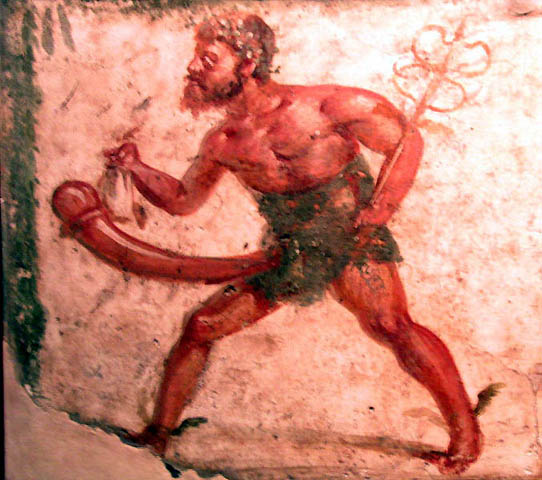
This "pun" has a possible parallel in Hebrew. The Hebrew for Jesus is Yeshua (YHShWH) which has only one more letter, also in the middle of the word, to Yahweh (YHWH). Yeshua is to Yahweh, as ichthys is to ithys, as fish is to erect phallus? Dick (!) came to believe that Christ reappeared to him in the form of the spirit of Bishop James Pike. The word pike refers also to both a fish and a straight spear or lance. The female/male dichotomy in this is also obvious. The lovers, the warring brothers, the two inverted fishes, dwell within these puns.
Of course this is all spurious etymology and certain blasphemy. It surely cannot be taken seriously, right? Likely not. If we consider, though, that the Logos enjoys tricks and, like McKenna's machine elves, multi-linguistic wordplay especially it might be worthwhile to explore these connections. To arrive at Yeshua from Yahweh we must add the Hebrew letter Shin. Shin means "tooth."
The Hebrew for "tooth" is shin, which is also the name of the twenty-first and penultimate letter of the Hebrew alphabet... The English equivalent to shin is "S" or "Sh". Perhaps because of its trident shape (literally, "three-toothed") and sibilant pronunciation, the kabbalists associated this letter with the element fire... Shin also appears somewhat like a descending dove, so it should come as no surprise that a relationship between it and the Holy Spirit exists. That the numerical value of both the letter taken by itself and the Hebrew phrase RUACH ALHIM ("the Spirit of God", usually translated "Elohim") is 300 serves to solidify the connection. The Spirit is often represented as a flame, one example being the tongues of fire that came to rest on the apostles' heads on that first Pentecost. Many spirits and other air elementals have been associated with fire as well.

In an excellent essay on Dick's life, Paul Rydeen also makes the connection of shin, the letter of the spirit, the fire and the tooth, with PKD's awakening experience in February of 1974 -- a time when Dick was in extreme pain from an impacted wisdom tooth. Rydeen looks further into the symbolism of the tooth:
In Freudian terms, the tooth can be a symbol of libido (not necessarily sexual). Dreaming of the loss of a tooth, for example, can represent a fear that one may lose one's standing in some way - physically or emotionally - or be a warning from the subconscious that this is threatening to happen. Note that one of Palmer Eldritch's three stigmata was his artificial teeth. Phil's impacted wisdom tooth was like his latent Gnosis, awaiting the proper stimulus to trigger his anamnesis. Another symbol of libido is the phalliform fish, whose sleek shape glides silently through the deep waters of the subconscious. As ICHTHYS, Christ strengthens our libido, our "psychic" energy, and asks nothing in return. He is UBIK, a negentropic force in a universe that is forever running itself down...
All Realms Are Real
The fish is also phallic. Ichthys is also ithys. The pike is a pike. And all of this is also related to the tooth. In The Transmigration of Timothy Archer the central character, Angel Archer, also has an awakening experience which is triggered by the pain of an abscessed tooth.
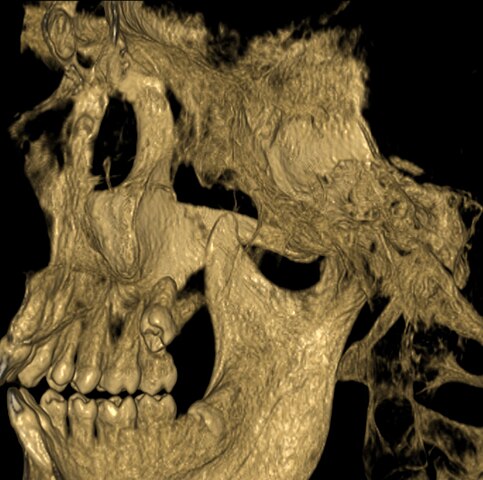
I remember the night I read that final canto of Paradiso, read it-truly read it-for the first time; I had that infected tooth and I hurt hideously, unbearably, so I sat up all night drinking bourbon-straight-and reading Dante, and at nine A.M. the next day I drove to the dentist's without phoning, without an appointment, showed up with tears dripping down my face, demanding that Dr. Davidson do something for me ... which he did. So that final canto is deeply impressed onto and into me; it is associated with terrible pain, and pain that went on for hours, into the night, so there was no one to talk to; and out of that I came to fathom the ultimate things in my own way, not a formal or official way but a way nonetheless.
Angel Archer (as a rational woman and an "angel" she is an inversion of Dick himself) tells exactly which part of the 33rd canto she is struck by. A blinding beam of light shines from the centre of the white rose of the Empyrean. Three coloured rings of light are visible, being the three parts of the Trinity. Angel Archer, in excruciating pain, like Dante can see with all of her being how the Three are One. The human is inseparable from the divine. This is her moment of anamnesis.
Within Its depthless clarity of substance
I saw the Great Light shine into three circles
in three clear colors bound in one same space;
the first seemed to reflect the next like a rainbow
on rainbow, and the third was like a flame
equally breached forth by the other two.

The pain and the crying and the sweating and stinking and cheap Jim Beam Bourbon was my Inferno and it wasn't imaginary; what I read bore the label "Paradiso" and Paradiso it was. This is the triumph of Dante's vision: that all the realms are real, none less than the others, none more than the others.
All realms are real and here at once. Angel confesses to Bishop Archer that she was "born that night" when the final mystery was revealed. Interestingly, Bishop Archer, AKA Jim Pike, answers that she had only began to be born. Her full birth, he explains, would only happen if she accompanied him into the Dead Sea Desert -- the place where Bishop Archer, like Bishop Pike, would later die alone. In Transmigration, though, the Bishop returns, in the Second Coming as it were, and quotes to her exactly these lines from Dante. From the desert He returns.

Turning and turning in the widening gyre
The falcon cannot hear the falconer;
Things fall apart; the centre cannot hold;
Mere anarchy is loosed upon the world,
The blood-dimmed tide is loosed, and everywhere
The ceremony of innocence is drowned;
The best lack all conviction, while the worst
Are full of passionate intensity.
Surely some revelation is at hand;
Surely the Second Coming is at hand.
The Second Coming! Hardly are those words out
When a vast image out of Spiritus Mundi
Troubles my sight: a waste of desert sand;
A shape with lion body and the head of a man,
A gaze blank and pitiless as the sun,
Is moving its slow thighs, while all about it
Wind shadows of the indignant desert birds.
The darkness drops again but now I know
That twenty centuries of stony sleep
Were vexed to nightmare by a rocking cradle,
And what rough beast, its hour come round at last,
Slouches towards Bethlehem to be born?
What is slouching towards Bethlehem from the desert? Beast or Hero or both? The twenty centuries of Pisces are over and we wake from stony sleep. Awaken to what?

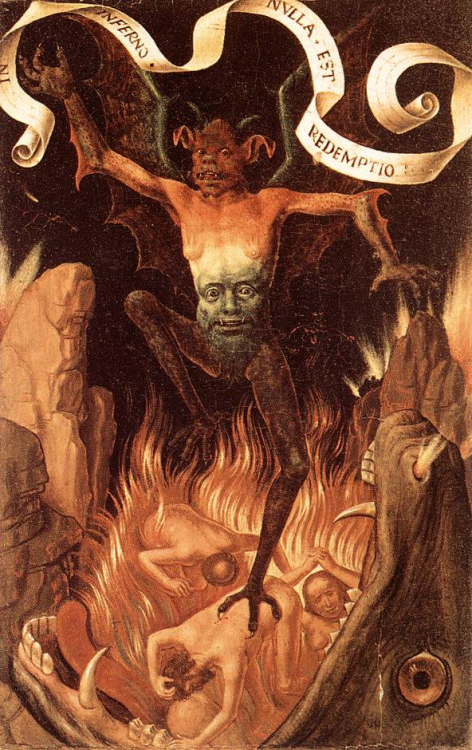
Plans Fulfilled
The righteous king is here -- King Felix but also the "Antipope" Felix, championed by St. Eusebius of Rome, who preached the "true" doctrine of the Trinity. Yet this is also the felix culpa, the "happy" fall that requires Christ's redemption, and it is the "Phoenix culprit" -- the indiscreet HCE who fell into sin and sleep in Phoenix Park.
But Finn again awakes with a splash of the waters of wisdom. Fish makes contact with tooth -- for Finn, for Dick, for Angel Archer, and to a much lesser extent to me on March 4th -- the day the McKenna brothers began the La Chorrera working. The Yes is there to be grasped at any instant. What does it mean? None of these visionaries arrive at a final answer. Only the dogmatic speak without irony or ambiguity.
Whether the godlike VALIS was involved at all, what was communicated to Dick seems to be approximately what the Freemasons and their brethren want us to believe about their mission: that theirs is an ancient tradition resting on an immortal bloodline that comes from the star system of Sirius, and that the fulfillment of their plans including the rebuilding of the Temple of Solomon, and the enthronement of a World King (their secret agenda hidden in their convoluted inner circle cant) is the only salvation for this soon-to-be One World.

This passage is from Jim Keith's Saucers of the Illuminati and it reveals a lot. What PKD, the actual person who had these experiences, struggled with for years and on thousands of pages offered scores of different interpretations, Jim Keith was seemingly able to provide the definitive answer for in only a few sentences. Keith latches onto the one theory Dick presents that meshes with Keith's own worldview -- that the "living information" was beamed into Dick's brain via CIA lasers.
It happens that information beam experiments of exactly the type that Dick speculated on were at about that time being conducted by both the CIA and the KGB.
Presumably Dick was being used, like McKenna and probably like Joyce, to perpetuate and advance the above-mentioned Freemasonic mythology that would eventually pave the way for a One World Religion. Certainly this cannot be ruled out. Something like this does appear to be happening and much evidence could be presented to support this view.

What is striking, though, and what sets the alarm bells ringing for me, is how sure Keith and other conspiracy theorists sound. Dick and the other authors give us multiple possibilities and let us decide for ourselves, or not decide. Conspiracy theorists, in contrast, tell us how it is. Which resembles more the authoritarianism we all inwardly despise?
Arrayed In Purple And Scarlet
A few more points can be added to finally round off these Ichtheology posts. The last pope resigned on Feb. 28th just as the constellation of the Crater, the Grail, was rising on the Eastern horizon over Rome. This same image is found on the Lust card, Atu XI, of Crowley's Thoth tarot deck. In the Book of Thoth, Crowley describes this card:
She rides astride the Beast; in her left hand she holds the reins, representing the passion which unites them. In her right she holds aloft the cup, the Holy Grail aflame with love and death. In this cup are mingled the elements of the sacrament of the Aeon.
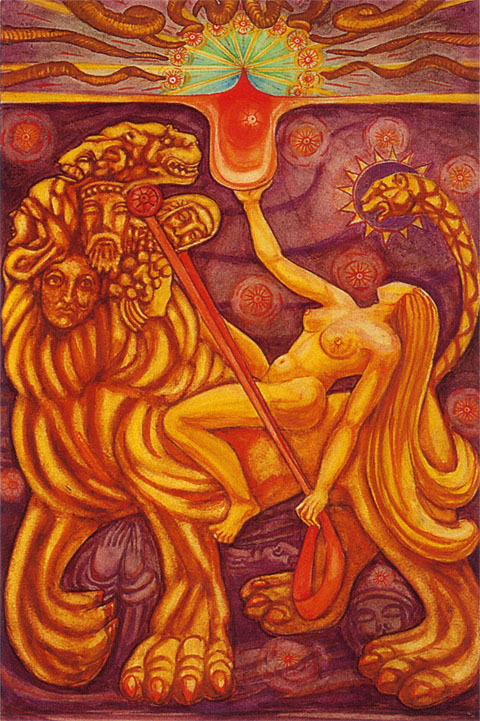
Much has been written recently on the esoteric importance of this card, so I will focus only on what may be relevant here. The imagery of the card has been directly taken from the Book of Revelation. The meaning, however, has been inverted in a way that should by now be quite familiar.
So he carried me away in the spirit into the wilderness: and I saw a woman sit upon a scarlet coloured beast, full of names of blasphemy, having seven heads and ten horns. And the woman was arrayed in purple and scarlet colour, and decked with gold and precious stones and pearls, having a golden cup in her hand full of abominations and filthiness of her fornication: And upon her forehead was a name written, MYSTERY, BABYLON THE GREAT, THE MOTHER OF HARLOTS AND ABOMINATIONS OF THE EARTH. And I saw the woman drunken with the blood of the saints, and with the blood of the martyrs of Jesus: and when I saw her, I wondered with great admiration. (17:3-6)
It is clear that Christians would not see this "golden cup...full of abominations" as being equivalent to the Holy Grail. Crowley (the "rough beast"?), however, explicitly does see these two cups as being one. How can this be? Crowley explains that the Lust card is assigned to the sign of Leo. Leo, being opposite of Aquarius in the Zodiac, is also a sign of the Aeon of Horus or the Age of Aquarius. The Grail held aloft by the woman astride the beast is thus a sign of the New Aeon.

The seers in the early days of the Aeon of Osiris foresaw the Manifestation of this coming Aeon in which we now live, and they regarded it with intense horror and fear, not understanding the precession of the Aeons, and regarding every change as catastrophe. This is the real interpretation of, and the reason for, the diatribes against the Beast and the Scarlet Woman in the XIII, XVII and XVIII-th chapters of the Apocalypse...
Like Jung, is Crowley merely accepting without fear the necessity of the union of opposites, however explosive the process, at the dawn of the new era? This whole line of thinking is terrifying for many Christians and those, like Jim Keith, who view it as the culmination of a complex, and frankly evil, ideology to entirely enslave us both physically and spiritually. I deeply share these concerns, but I suspect that fear is the natural response to intense yet required change.
The fact that this sign appeared as the last pope in St. Malachy's prophecy (most scholars consider "Peter the Roman" to be a more recent addition, and in any case the 112th pope does not figure into Finnegans Wake) seems to correspond nicely with Atu XI. Pope Francis, according to some, is turning out to be a very different leader than his predecessors. This blog has suggested before that Joyce hinted that the line of the 111 popes would end with the return of Brigid. Is Francis her emissary? Is she the scarlet woman riding the beast?

The contents of the cup she holds, the "abominations" which are really inversions of the bread and wine of the Eucharist, recall the bread and broth of the sacred mushroom that Timothy Archer, following John Allegro, believed were the real sacraments of the early Christians. Terence McKenna differed with Allegro on the type of mushroom used (psilocybes and not Amanita muscaria), but both agreed that the fungus conveyed living information.

A Fishy Theology
Crowley, and it would seem also Joyce, viewed the new aeon as beginning in the year 1904. An interesting online article points out that both 1904, when Crowley was channeling the Book of the Law in Egypt, and 1973-4, when Timothy Leary, Robert Anton Wilson, PKD and others were all receiving "transmissions" from Sirius, were years when the Dogon people of Mali celebrated their major festival of the Sigui. This religious ceremony is held every 60 years, lasting for several years each time, and honours the star Sirius.

Twenty years after 1973, 1993 -- the year I had the first of my tooth mishaps -- was also an important year for Sirius. In 1993-4, Sirius was at its closest distance, within a 49.9 year cycle, to its companion star, Sirius B. Is there a twenty year pulse or rhythm involving Sirius? Is this star a source of the plasmate? Is it, as Dick wrote, the origin of both VALIS and Belial? Or is this only a projection, a freemasonic hoodwink, as Jim Keith suggests?
This year, 2013, marks another twenty years and the resonances are definitely being felt. On the day the new pope officially took office, March 13th, it was announced in the media that an ancient Coptic text was deciphered indicating that Jesus was a shape-shifter! The ever-transforming Zebra continues to reveal itself. The plasmate continues to invade from the desert.

One last set of symbols can perhaps tie a lot of this together. After the Boston bombing, as well as in the aftermath of the Sandy Hook shooting, a team of friendly Golden Retriever "K-9 Comfort Dogs" were sent out by a organization of Lutheran churches to provide emotional support for the victims. This, of course, instantly brings to mind Sirius, the yellow lab retriever and number 17 of the K-9 police unit, who died in action on 9/11. The noble spirit of Sirius is clearly present within these new K-9 (11/9) teams. And what is their symbol? The ichthys.

And what shaggy, shape-shifting, friendly/terrible, pun-mongering beast slouches towards Bethlehem to be bored?




